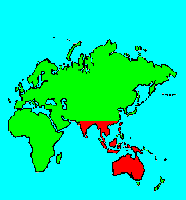SPECIES INFO
Rufus backed kingfisher (Ceryx erithacus form rufidorsus to Ceryx rufidorsa) is found from India to the Philippines. This is also found in Malaysia, Sumatra, Borneo, and Java. Since this bird is frequently referred to as a form of C. erithacus, one must be careful of precise historical range data. This tiny kingfisher has a yellow breast, orange back and upper wings with a black leading edge to the upper wings. (Intermediates between C. rufidorsa and C. erithacus are common, adding confusion to the status of this form.)Ceryx genus of kingfishers is found from SE Asia and the Philippines to Australia and New Guinea. There are 5 species. These are generally small kingfishers with short tails normally less than 6 inches total length.
There are two African and 1 Madagascar species that have been moved into this genus to bring the genus member count to 7 species.
The Alcedo group of kingfishers is found in Africa and also southern Asia and south into the Indo-Australian region. There are no representatives in the New World. There are 25 species in this group. The Alcedo genus contains 17 species. The Ceryx genus contains 5 species. The new Ispidina genus (split from Ceryx and sometimes referred to as Myioceryx) contains 3 species.
Kingfishers (Family Alcedinidae) are a family of 84 species of birds that are found virtually worldwide. They generally have long bills. Many species dive into the water for their food. (Modern authors divide this family into three families: Alcedinidae, Halyconidae, and Cerylidae.)
Hornbills, rollers, and kingfishers (Order Coraciformes) are characterized by having their three front toes joined for a portion of their length. There are seven families in this order.
Aves contains about 8,650 different species of living birds known to science. Each year about one new species is discovered in some remote rain forest or remote island. In addition, scientists have been raising many subspecies to full species status which may raise the species count to 10,000. Birdlife recognizes 10,027 species as of 2011.
However, each year about one species goes extinct. The rate of extinction is increasing, and the rate of new discovery is decreasing, so that the number of bird species will soon begin to decline rapidly. Although different taxonomists would organize the birds differently, there are approximately twenty-seven orders of birds. These orders are broken down into about one hundred and fifty-five different families.
Recent research of the genetic structure of some of the shore birds and owls would indicate that the present organization of orders and families should have some modification.
The birds are a worldwide group of animals that are characterized by having the front limbs modified into wings that are used for flying. Perhaps the most unique feature of the birds is the feathers. These feathers are made up of a central support called a quill and a series of small filaments that are hooked together as barbs.
For many years it was believed that Archaeopteryx discovered in Bavaria was the oldest bird from about 150 million years ago. However, in l986, Sankar Chattterjee, a Texas paleontologist, reportedly discovered a bird in the genus Protoavis that lived about 225 million years ago.
When this project was begun in 1978, we used Austin & Singer for bird taxonomy. Since then, we have adopted many changes, but have kept some older concepts that are still found widely in the literature. Recently, we have used Clements and Howard & Moore. Very recently, we have used Monroe and Sibley for the higher taxonomy of the perching birds.
Backboned Animals (Phylum Chordata) are the most advanced group of animals on earth. These animals are characterized by having a spinal cord or backbone. Most members have a clearly defined brain that controls the organism through a spinal cord. Fish, amphibians, reptiles, birds, and mammals are in this phylum.
Currently, some taxonomists believe that the fish should be divided into two groups (sharks and regular fishes) and that there are some other primitive groups in the phylum such as hagfish or lampreys.
Animal Kingdom contains numerous organisms that feed on other animals or plants. Included in the animal kingdom are the lower marine invertebrates such as sponges and corals, the jointed legged animals such as insects and spiders, and the backboned animals such as fish, amphibians, reptiles, birds, and mammals.

